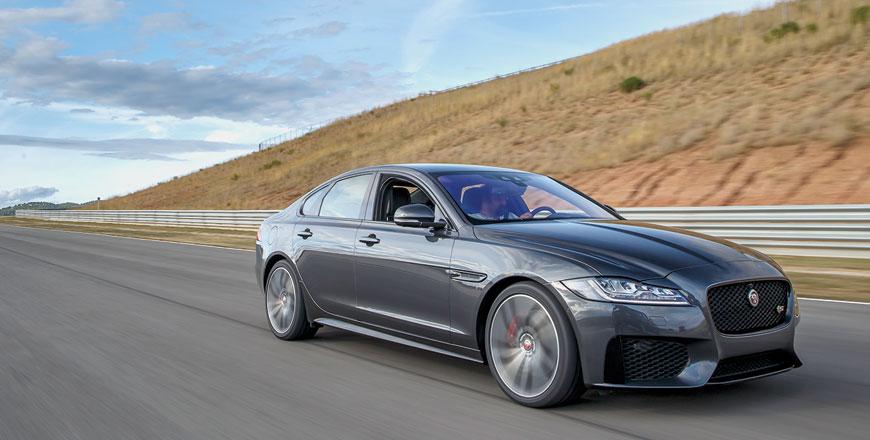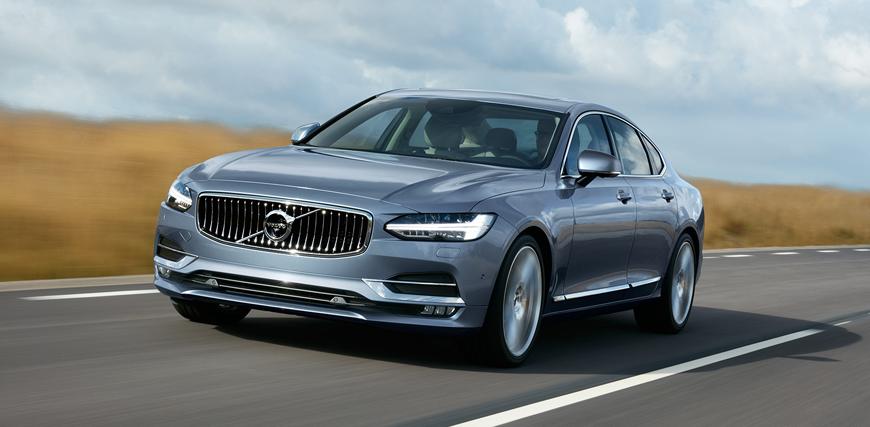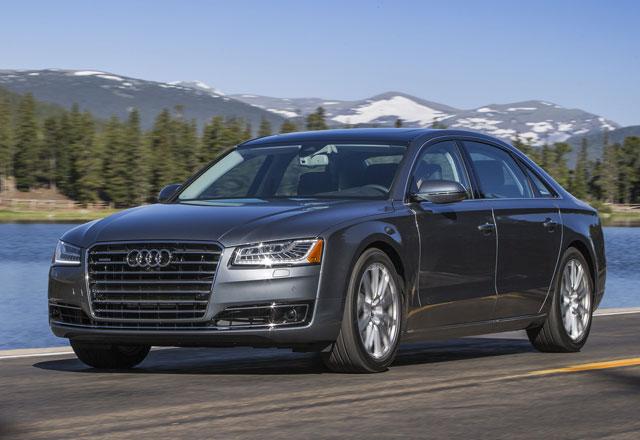You are here
Jaguar XF S 3.0 Supercharged V6 380 AWD: All-paw ability and performance
By Ghaith Madadha - Nov 30,2015 - Last updated at Nov 30,2015

Photo courtesy of Jaguar
The car that launched Jaguar’s fresh contemporary design language in 2007, it seems not long ago that the XF succeeded the now defunct S-Type as Britain’s gambit into the hotly competitive and German-dominated executive saloon segment. Now gaining aluminium construction — like other Jaguar models — the second generation XF was introduced globally in September and arrived in Jordan last week.
Marginally smaller yet roomier and up to 190kg lighter owing to aluminium construction, the new XF also features a comprehensively modern infotainment and driver assistance technology suite. Driven in current range-topping guise at the global launch in northern Spain, the XF 3.0 Supercharged V6 380 AWD (All-Wheel Drive) offers brisk performance, lithe rear-drive-like handling but with reassuring four-wheel drive roadholding.
Sculpted successor
An evolutionary design, the new XF is a classier yet sharper successor this more sculpted and with sharper. Featuring a snoutier more jutting and upright honeycomb grille it also receives a more muscularly ridged bonnet, bigger side air intakes and slimmer browed headlights with ‘J’ LED motifs, while a lower waistline with prominently defined ridges lend better visibility.
While short front overhang and long rear boot emphasise classic proportions, the XF’s strong shoulders and rakish roofline lend it a road-huggingly alert stance. Weighing in at 1,760kg — as tested — the XF is also 11 per cent lighter and 28 per cent stiffer owing to 75 per cent aluminium content construction. With 51mm longer wheelbase the XF benefits from better stability, rear legroom and 27mm more rear headroo, despite being 7mm shorter and 3mm lower.
Nestled below its elegantly long bonnet, the driven XF S is powered by Jaguar’s now familiar 3-litre direct injection supercharged V6 engine, mated to a slick, smooth and swift shifting 8-speed automatic gearbox. Developing 375BHP at 6500rpm and 332lb/ft at 4500rpm, the XF S pounces off the line with immediacy and no lag, owing to mechanical supercharged induction, rising with progressive urgency to its rev limit.
Fast feline
Putting power down through all four wheels when necessary for improved traction, the 50kg heavier XF S 3.0 AWD is marginally quicker off-the-line than its rear drive sister model and while 0.1-second quicker in 0-97km/h acceleration. The difference, however, closes in by 100km/h at 5.3 seconds for both versions. Topping an electronically-governed 250km/h top speed, the XF S AWD returns restrained 8.6l/100km combined fuel efficiency.
Ostensibly operating as a rear-wheel-drive car for traditional feel, handling balance and 10 per cent efficiency improvement, the XF S can divert between 100 per cent power rear wards and up to 80 per cent frontwards to maintain traction and roadholding when necessary. Using a lightweight chain-driven four-wheel drive transfer, the XF S variable on-demand system is 16 per cent lighter than its predecessor. A limited-slip differential to actively distribute power along the rear axle is, however, not available.
With variable four-wheel drive and low traction electronic driver assistance systems the XF S AWD’s advange is most evident on low traction surfaces, and proved its mettle in aggressive tight wet obstacle course driving exercise. Squiggling and clawing back traction through tight turns and heavy low gear throttle inputs, the XF S AWD was manoeuvrable and controllable, where a similar rear drive car would have been out of its depth.
Clawing and pouncing
Built on a stiff and light aluminium platform and with balanced weighting, the XF S is dynamically eager and intuitive in, through and out of corners. Riding on sophisticated front double wishbone and rear integral link suspension, the XF S features independent dynamic tuning, including supple longitudinally settings for ride comfort and stiff lateral camber and castor settings for confident handling.
Driven at the winding 3.93km long Circuito de Navarra, the XF S AWD was smooth, refined, confident and supple in a straight line, with its indefatigable supercharged engine pulling with consistently urgent progression to well above 200km/h. With adaptive damping system it conversely proved well-controlled in dealing with lateral weight transfer and body lean, through corners.
If not as pure or intuitive as its non-AWD sister, the all-paw nevertheless proved agile, effective and reassuringly capable at Navarra. Peeling back speed confidence as one hit the brakes, the XF S tidily turns into corners, its steering direct, quick and refined. With its engine digging deep and finding a muscularly versatile mid-range, the XF S AWD clawing hard into tarmac, tightens its line and pounces out onto the straight.
Uncluttered clarity
Refined and well-insulated inside, the XF’s cabin has a sophisticatedly contemporary and classy ambiance of uncluttered clarity, with quality leathers, real metals and supple textures aplenty. Roomier and with better visibility than before, the XF features a supportive, comfortable and ergonomic driving position with highly adjustable seats and steering, along with user-friendly controls.
Thoroughly well-equipped, the XF features a choice of two intuitive 10.2-inch infotainment system options. Along with standard gesture and voice control and text-to-voice tech, the optional smartphone-like InControl Touch Pro adds a quad-core processer, 60GB solid state drive, Ethernet connectivity, various apps, smooth crisp graphics and approach view and dead reckoning interactive satnav even able to position the vehicle without a GPS signal.
In addition to extensive driver assistance systems, the XF features All Surface Progress Control, coupled with Adaptive Surface Control (AdSR) for AWD versions. Derived from sister brand Land Rover’s extensive off-road expertise, the former acts as sure-footed low-speed cruise control, operating between 3.6-30km/h on low friction surfaces and the latter identifies and adapts engine, steering, stability controls and steering for surfaces such as snow or gravel.
TECHNICAL SPECIFICATIONS
Engine: 3-litre, supercharged, in-line V6 cylinders
Bore x stroke: 84.5 x 89mm
Compression ratio: 10.5:1
Valve-train: 24-valve, DOHC, continuously variable valve timing, direct injection
Gearbox: 8-speed automatic, four-wheel drive
Ratios: 1st 4.714; 2nd 3.143; 3rd 2.106; 4th 1.667; 5th 1.285; 6th 1.0; 7th 0.839; 8th 0.667
Reverse / final drive: 3.317 / 3.23
Power, BHP (PS) [kW]: 375 (380) [280] @ 6500rpm
Specific power: 112BHP/litre
Power -to-weight ratio: 213BHP/tonne
Torque, lb/ft (Nm): 332 (450) @4500rpm
Specific torque: 150.25Nm/litre
Torque-to-weight ratio: 255.68Nm/tonne
0-100km/h: 5.3 seconds
Top speed: 250km/h
Fuel economy, combined: 8.6 litres/100km
CO2 emissions, combined: 204g/km
Fuel capacity: 74 litres
Length: 4,954mm
Width: 1,880mm
Height: 1,457mm
Wheelbase: 2,960mm
Track, F/R: 1,605 / 1,594mm
Ground clearance (fully laden): 116mm
Headroom, F/R: 991/970mm
Boot capacity: 540 litres
Kerb weight: 1,760kg
Suspension, F/R: Double wishbones/integral link
Steering: Variable electric-assisted rack & pinion
Turning circle: 11.61 metres
Brakes: Ventilated discs
Tyres: 255/35R20 (optional)
Related Articles
As respected as auto manufacturers come, Volvo has long been synonymous with Swedish sensibility, automotive safety, thorough engineering an
A breakthrough model for Audi’s luxury car ambitions and successor to the four-ring brand’s first 1988-93 Audi V8 effort, the A8 effectively pole-vaulted Audi into the heart of the full-size luxury flagship segment.
A car-like SUV, the crossover segment’s origins are difficult to pin down.


















